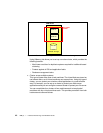Chapter 2. Positioning 37
VMware many file and print servers that are distributed around the enterprise
can be consolidated to a four-way x440 server, reducing the TCO.
Using logical partitioning with four-way configurations can produce a one-box
cluster solution for small-to-medium-sized businesses (SMB) that need to
protect their mission-critical applications and files. With this solution, SMB
customers can reduce their total cost of ownership and save money.
In addition, a four-way x440 can be a good platform for light ERP solutions
such as Navision.
Eight-way and 16-way configurations:
The eight-way and 16-way x440 is ideal for customers who want to
consolidate their enterprise applications (ERP, CRM, and SCM) or roll out
new enterprise applications. These configurations offer computing power,
high availability, and reliability, which are the main requirements when running
enterprise applications. The goal is to help customers to control their
expenses while establishing an environment that is easier to manage
because of fewer nodes.
The eight-way and 16-way configurations are solid platforms to be used for
consolidating database applications such as DB2, SQL Server, and Oracle.
For instance, a single database that spans multiple servers can be
consolidated to an eight-way x440 server or multiple databases on multiple
server can be consolidated to a 16-way x440 complex.
Many customers have multiple databases distributed on multiple sites and
they are planning to migrate to new database versions. This could be a very
costly and time-intensive process. The migration process needs to be well
planned and tested without any interruption of the business process. The
eight-way or 16-way can be an optimal platform for these customers. For
example, you can consolidate the distributed databases on multiple sites to a
16-way x440. Using logical partitioning on x440, you can build, test and
deploy many virtual databases on one physical server.
The main reasons to consolidate database applications are:
– Migration from older database versions to new versions getting the
advantages relating to availability, reliability and performance.
– Support for more databases. For instance, SQL Server 2000 can support
up to 32,767 open databases.
– Reducing the management costs of distributed database sites by
consolidating to an easy-to-manage central site.
In addition, using logical partitioning with eight-way and 16-way configurations
can produce a powerful server solution that is capable of hosting multiple
applications.


















